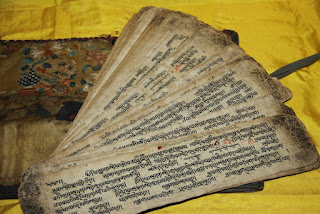Terma BUDDHIST
Terma (Tibetan: གཏེར་མ་, Wylie: gter ma; "hidden treasure") are key Tibetan Buddhist and Bön teachings, which the tradition holds were originally esoterically hidden by various adepts such as Padmasambhava and his consorts in the 8th century for future discovery at auspicious times by other adepts, known as tertöns. As such, they represent a tradition of continuing revelation in Buddhism. The majority of terma teachings are tantric in nature, although there are notable exceptions.
PHURPA TERMA
PRAYER BOOK TERMA
THANGKA TERMA
LAMA YIDAM KHANDRO TERMA DAGGER
Types of terma
Termas are of two main kinds: earth treasures and intention, or mind, treasures. A teaching concealed as an intention treasure appears directly within the mind of the tertön in the form of sounds or letters to fulfill the enlightened intention of Padmakara. Earth treasures include not only texts, but also sacred images, ritual instruments, and medicinal substances, and are found in many places: temples, monuments, statues, mountains, rocks, trees, lakes, and even the sky. In the case of texts, they are not, as one might imagine, ordinary books that can be read straightaway. Occasionally, full-length texts are found, but they are usually fragmentary, sometimes consisting of only a word or two, and they are encoded in symbolic script, which may change mysteriously and often disappears completely once it has been transcribed. They are simply the material supports that act as a trigger to help the tertön reach the subtle level of mind where the teaching has really been concealed. It is the tertön who actually composes and writes down the resulting text, and so may be considered its author.The earth-terma are physical objects — which may be either an actual text, or physical objects that trigger a recollection of the teaching. The mind-terma are constituted by space and are placed via guru-transmission, or realizations achieved in meditation which connect the practitioner directly with the essential content of the teaching in one simultaneous experience. Once this has occurred, the tertön holds the complete teaching in mind and is required by convention to transcribe the terma twice from memory (if of textual nature) in one uninterrupted session. The transcriptions are then compared and if no discrepancy or inconsistency is evident, the terma is sealed as authentic. The tertön is required to realise the essence of the terma prior to formal transmission.
In one sense, all terma may be considered as mind-terma as the teaching associated is always inserted in the mind of the practitioner, in other words the terma is always a direct mindstream transmission from the vidyadhara. The terma may also be held in the mindstream of the tertön and realised in a future incarnation at a beneficent time. A vision of a syllable or symbol may leaven the realisation of the latent terma in the mindstream of the tertön. The process of hiding in the mindstream implies that the practitioner is to gain realisation in that life. At the time of terma concealment, a prophecy is generally made concerning the circumstances in which the teaching will be re-accessed. Especially in the case of an earth-terma, this usually includes a description of locality, and may specify certain ritual tools or objects which are required to be present, and the identities of any assistants and consorts who are required to accompany or assist the tertön.
Though somewhat contentious, the kind of revealed teaching embodied in the terma system is based in solid Mahayana Buddhist traditions. The example of Nagarjuna is often cited; the Prajnaparamita teachings are traditionally said to have been conferred on Nagarjuna by the King of the nāgas, who had been guarding them at the bottom of a lake. Similarly, the Six Treatises of Asanga are considered to have been conferred on him by the Buddha Maitreya, whom he visited in Tushita heaven during a vision.
"Pure visions" are pure teachings received from the vision of deities and are not necessarily terma as they do not require mindstream transmission from a vidyadhara to the practitioner experiencing the pure vision. The esoteric teachings resulting from pure vision are based on the tantras and are sometimes attributed as terma due to their merit.















